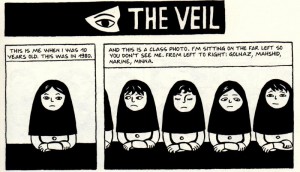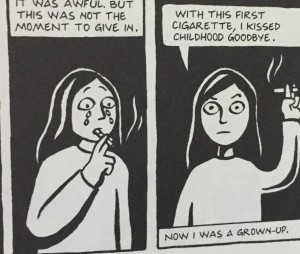Hello readers!
The last few weeks of my ASTU class involved discussions about the different aspects of “Persepolis” as a graphical memoir. This week in my ASTU class we also discussed about “Persepolis” offering a “testimony” based on ‘eyewitness’ memory. Testimony in literature is often an autobiographical narratives or is an evidence provided by the first person account about human rights abuses, violence, war and living under conditions of social oppression. Testimonies can be perspective of an individual about their past memories which are generally about the trauma and experiences of the individual.
As discussed in my ASTU class, “Persepolis” being a personal story of Marjane Satrapi provides us with a testimony which is based on “I” or “eye” witness i.e the circumstances and experiences encountered by her during the Islamic Revolution and Iran-Iraq war. She provides us with ‘her’ intimate details and is ‘herself’ an evidence of the war. Satrapi makes it clear in her graphical memoir “Persepolis” about telling us and showing us what she ‘wants’ us to see, which is quite evident from this picture.
This is one of the reason as to why “eyewitness testimonies” are usually criticized for being an unreliable source. ‘Personal’ memory and ‘ personal perspective’ which is a major element of eyewitness testimonies in literature are usually considered to be biased and modified according to the views and wish of the individual. Eyewitness testimonies connect ‘history’ with ‘literature’ but unclear memory of an individual about the history can lead to misleading memory of the original incident. The doubt about the accuracy of eyewitness testimonies makes it a topic for debate for many scholars which according to me is justifiable because one’s memories tend to change over time or may be lost in the process of reminiscing. Marjane Satrapi wanted to show its readers the ‘real’ image of Iran during the war as she mention in the Introduction of her book “Persepolis”, “……..As an Iranian who has lived more than half of her life in Iran, I know that this image is far from the truth. This is why Persepolis was so important to me” , but the ‘doubtful accuracy’ and ‘personal perspective’ of ‘eyewitness testimony’ makes me question about the ‘precision’ of the image of Iran she created in our minds through “Persepolis”. If Satrapi thought that the image of Iran in the mind of people was far from the truth, is it possible that the image of Iran she created through “Persepolis” is also not the complete ‘reality’? Who knows?


